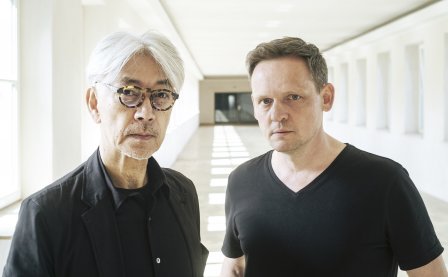One of the distinguishing qualities of ambient music is the way in which it makes us consider the relationship between sound and environment. More so than any other sonic form, it envelops the space that it’s produced and listened in through its patient unfolding. It slowly shapes the environment and creates an affect space that can become imperceptible to the listener, as if natural to the surroundings. Drones and arrhythmic sounds remind us of the sonics we perceive as natural, weaving in and out of perception: car motor running idly outside, an animal calling somewhere, the white noise of rain. In a way, ambient music is always site-specific music, but in a manner akin to a feedback loop rather than to straightforward determination.
Glass can be seen as such a piece of music, very much so because of the way it was created. A live, intimate concert of Ryuichi Sakamoto and Alva Noto, which happened in the famous Philip Johnson’s Glass House, worked the environment into the performance. Contact mics were placed around the building and attached to its glass structure; this way, due to the resonant qualities of glass, the building would become an instrument in the form of the aforementioned feedback loop. It would not only transmit sounds made by its structure or surroundings, but also amplify the sounds produced by the artists. The environment shaped by waves of sound would flow back into the sound itself, a reciprocal relationship rather than mere creation. It’s only natural then that the album consists of a single piece just below 40 minutes; the resulting recording is a documentation of an improvised sonic space rather than a conscious, planned piece of music.
It’s interesting to consider it as such, because it inevitably invites the question that always haunted field recordings: namely, whether such a thing as a sonic space can be reproduced when listened to elsewhere and to what degree can it be impactful outside the space of its origin. Glass succeeds in answering this question by choosing not to play its game or by being a faithful reproduction, but rather by retaining the ability to flow into a space and make it its own. It’s a patient piece, one that washes over our attention rather than forcing itself upon it. From its almost silent begging, it slowly envelops our surroundings to the point where they feel empty after the album ends, as if something natural to them were removed. Even the more abrupt of its assortment of sounds, such as the alien cries produced by Sakamoto dragging a contact mic on the glass, don’t feel sudden. They create folds in our perception, moving in and out of its range naturally, much like one perceives a bird song outside the window when just a moment ago it was all quiet. This is the point where ambient music is environmental music, weaving itself into our surroundings to become indistinguishable from them.
In that way, Glass is a very different record from previous collaborations of Ryuichi Sakamoto and Alva Noto. There was always a lot of starkness and coldness to their music; it demanded our attention in its quietest moments and completely took it over in its most aggressive. It was never any wonder that the digital sounds of Alva Noto were uncompromising in this regard, but even the piano of Sakamoto, often played very softly, was mixed in such a way as to make it very forward and clear. It was not devoid of affect, but it always felt alienating to a certain degree. But even though Glass has a lot of physicality to it, it’s gentle in the ways in which it fills our space with its presence. It’s a record one loops for the evening and unconsciously forgets about it, only to wonder what is missing when it stops playing.
More about: Alva Noto, Ryuichi Sakamoto




